As a new decade dawned, the rest of the
war-torn South was still pushing through rebuilding efforts that would last
another three years until Reconstruction officially ended in 1873. But by 1870
the wooden buildings that housed Galveston’s
business district along The Strand had already been rebuilt and destroyed again
by another formidable foe—fire.
However the economic growth of the port had outpaced even that of the
city’s geographical footprint since the federal blockades were lifted after the
war, and the ever-expanding wealth of the island’s entrepreneurial population
now had the impetus and capital to build structures that would showcase
Galveston’s commercial dominance and prove once and for all its stature as an
international port. The architectural prowess discovered within this time would
prove nearly immortal, as the majority of the buildings constructed during this
era still stand today and together comprise one of the most comprehensive
examples of Victorian architecture anywhere in the nation.
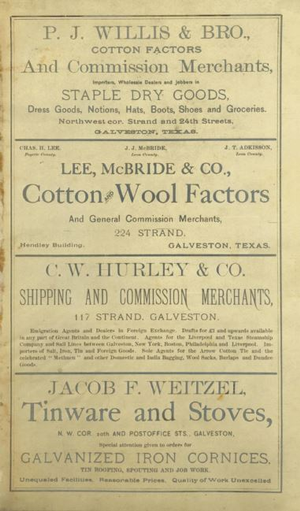 Henry Rosenberg, who would later bequeath the entirety of his estate to
the city and establish himself as an eternal Island icon, led the new wave of
construction in 1870 with two buildings on the south side of The Strand between
23rd and 24th Streets, just east of the Merchants Mutual
Insurance Company Building. Built of brick with three stories and iron façades,
the pair were designed to resemble each other to give the illusion that they
were one building.
Henry Rosenberg, who would later bequeath the entirety of his estate to
the city and establish himself as an eternal Island icon, led the new wave of
construction in 1870 with two buildings on the south side of The Strand between
23rd and 24th Streets, just east of the Merchants Mutual
Insurance Company Building. Built of brick with three stories and iron façades,
the pair were designed to resemble each other to give the illusion that they
were one building.
The
Rosenberg Building
(2309-2311 Strand) would later be occupied by the Telephone Company in the
1880s, and The J.F. Magale Building (2313-2315) was named after a wholesale
liquor dealer who partnered with Rosenberg
for its completion and operated out of the building until the 1890s.
At the end of the block on the southeast corner of 24th Street rose another 1870
addition, the imposing Ullmann, Lewis, & Company Building that included a
cigar shop in addition to a wholesale grocer and liquor outlet. Originally a
three-story structure, it was reduced to a single story after the 1943
hurricane. Also referred to as the Phoenix
Building in honor of Galveston’s
famously bygone bakery, only a portion of it still remains at 2325 Strand.
That year’s vertical improvements concluded
with the construction of an impressive warehouse on the northeast corner of 22nd Street
that housed one of Galveston’s
most prominent hardware firms. The J.S.
Brown Hardware
Company Building
(2226-2228) was lauded for using the best Texas brick available, with a firm cement
foundation that stretched below sea level.
Although now unrecognizable because of a renovation that combined
several adjacent buildings in the Old
Galveston Square, the T.W.
House Building
(2219) was built in 1871 as the headquarters of the largest dry goods
wholesaler in the entire state of Texas.
The front of the building showcased double-leaf doors set against brick columns
encased in cast iron detailing. T.W. House retained a personal residence in Houston, but built that city’s first great fortune through
his Galveston
enterprise. His son, Edward M. House, served as President Woodrow Wilson’s
chief advisor.
In 1872 the site of Moro Castle at 23rd
Street became the location of one of the largest
buildings to date, the Thomas
Jefferson League
Building (2301-2307).
Stunning cast iron columns enveloped glass storefronts on the street level and
rose into two additional stories flanked entirely by windows and cast iron
ornamentation.
Also built in 1872 was The Strand’s most modest survivor of the ages, a
one-story building commissioned by Michel B. Menard’s brother-in-law, Isidore
LeClere, who was the very first secretary of the Galveston Wharf Company where
he served for twenty-five years.
Spurred by the momentum of the private construction, the mid 1870s were
also witness to infrastructure improvements taken on by the city, most notably
the much needed filling of Avenue A, which up until this time was merely a
technical name for the shoreline between The Strand and the harbor. Once filled
and paved, the efficiency of travel to and from the wharf became exponentially
easier and more efficient, and was made even more so when a wharf railroad was
installed along the water.
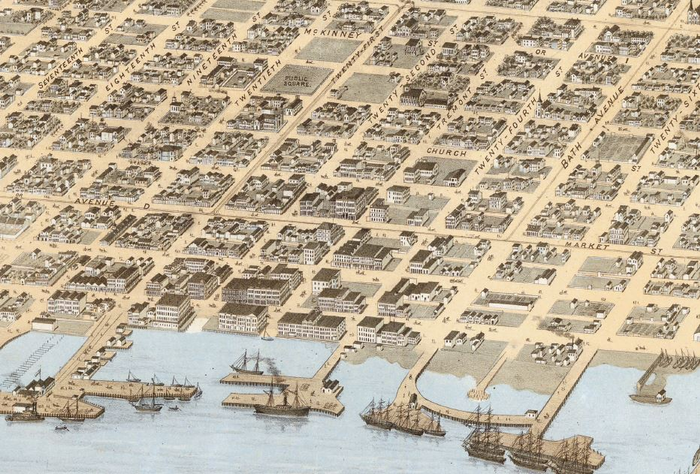 Previously
relegated to horse and buggy for the transport of goods between the railyard
and the wharf, shippers and manufacturers were now able to more expediently
deliver to and within the commercial district.
Previously
relegated to horse and buggy for the transport of goods between the railyard
and the wharf, shippers and manufacturers were now able to more expediently
deliver to and within the commercial district.
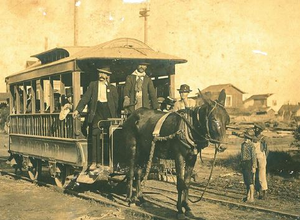 Henry Rosenberg constructed his third building at the far eastern end of
The Strand at the corner of 20th
Street across from Hendley Row. Yet another
investment property for the wealthy banker, the $20,000 project was completed
in 1876 and featured an arcade on the ground floor with multiple storefronts
and offices on the second floor. Tall, arched windows lent distinction to the
upper levels as did decorative square pilings that flanked the upper portion of
the façade.
Henry Rosenberg constructed his third building at the far eastern end of
The Strand at the corner of 20th
Street across from Hendley Row. Yet another
investment property for the wealthy banker, the $20,000 project was completed
in 1876 and featured an arcade on the ground floor with multiple storefronts
and offices on the second floor. Tall, arched windows lent distinction to the
upper levels as did decorative square pilings that flanked the upper portion of
the façade.
In 1877, the Wallis, Landes, & Company Building (2411) was constructed
by a wholesale grocery firm. From Galveston they
secured a business territory that stretched across Texas,
Louisiana, Arkansas,
New Mexico,
and even some yet unclaimed land to the west. Across 24th Street, the south side of
that block was at last completed when a new Bolton Estate
Building (2321-2323) was
erected between Merchants Mutual and Ullmann, Lewis, & Co. after a fire
destroyed the original the year prior.
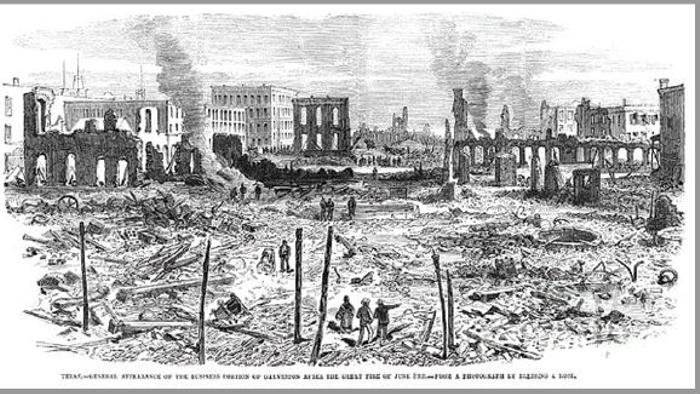 The
building was occupied by J.F. Smith & Brother, a hardware dealership whose
network traveled across the southwestern United States. They remained in
business until the late 1960s, and the building has since been home to Galveston’s famous
LaKing’s Confectionery.
The
building was occupied by J.F. Smith & Brother, a hardware dealership whose
network traveled across the southwestern United States. They remained in
business until the late 1960s, and the building has since been home to Galveston’s famous
LaKing’s Confectionery.
A
couple of blocks away, yet another fire claimed several buildings between 21st
and 22nd in 1877. On the north side of the street, the original Mallory Produce Building
(2114) was completely destroyed, and across the street the First National Bank
at the corner of 22nd was consumed along with all of the neighboring
structures. C.D. Mallory completely rebuilt his produce house in almost exact
replica, complete with hood-molding over the upper windows; below,
floor-to-ceiling windows were set into a row of double doors that lined the
entirety of the storefront.
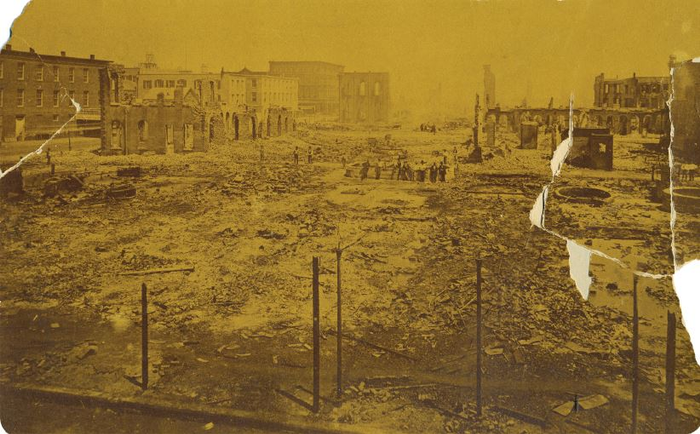 The First National Bank Building (2127) was also rebuilt but reduced to
its current two-story structure designed by Thompson Harden. In her
comprehensive guide The Strand of
Galveston, author Virginia Eisenhour speculates that “the original
Corinthian-patterned ironwork survived [the fire] and [was] used in the new
building.”
The First National Bank Building (2127) was also rebuilt but reduced to
its current two-story structure designed by Thompson Harden. In her
comprehensive guide The Strand of
Galveston, author Virginia Eisenhour speculates that “the original
Corinthian-patterned ironwork survived [the fire] and [was] used in the new
building.”
The adjacent lot to the east would remain vacant for many years after
the fire, but the remainder of the 21st block of The Strand remained
under construction for the duration of 1878. A woman named Mrs. Clara Lang
hired architect John Moser to construct one of two four-story buildings (2119)
from pressed brick with an artificial stone trim that has since been covered
with stucco, the same fate endured by the Marx and Kempner Building (2117) next
door that was built at the same time.
Continuing east, door to door, the Opperman Building (2115) was designed
by H. Pritchard was an investment property with a faux iron façade made from
cement and plaster that was immediately leased to cotton factor and farm
machinery merchant Joel B. Wolfe.
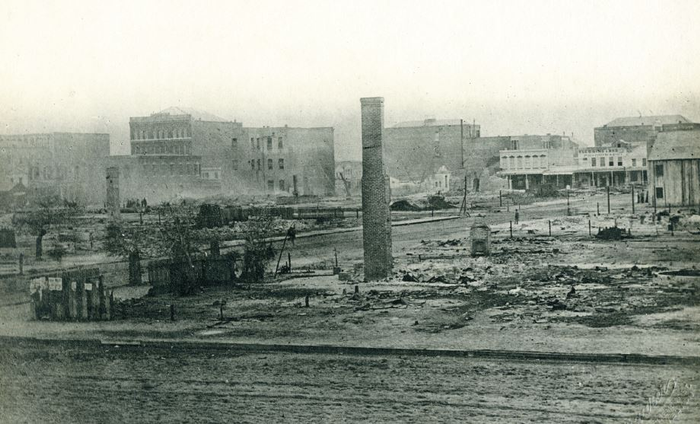 The two-story J.S. Brown Building
(2111) was famed Galveston
architect Nicholas Clayton’s very first appearance on The Strand, but it would
certainly not be his last. The modest two story structure was subtly ornamented
with Clayton’s trademark artistic nuance but it would soon pale in comparison
to his future works.
The two-story J.S. Brown Building
(2111) was famed Galveston
architect Nicholas Clayton’s very first appearance on The Strand, but it would
certainly not be his last. The modest two story structure was subtly ornamented
with Clayton’s trademark artistic nuance but it would soon pale in comparison
to his future works.
Next to it was the second of Mrs. Lang’s buildings (2109), and the
eastern end of the block was capped off by the Ball, Hutchings, & Company
Building (2101), both completed in 1878. A simple design with a stucco finish
and modest cornice, the latter building and its pointed archways housed a
grocery business and would later become home to one of the first Western Union
Telegraph offices.
The last of the buildings from this decade has since been demolished,
but in 1879 the widow of the second president of the Republic
of Texas, Henrietta Lamar, built a
small investment property at 2304 Strand that
was leased to several different commission merchants.
 By the end of the 1870s, Galveston
was ranked third in the nation in cotton exports, and its booming commercial
district was now beginning to look the part. The city, however, had still not
reached its ultimate zenith, economically or architecturally, and some of The
Strand’s most monumental achievements were yet to be accomplished.
By the end of the 1870s, Galveston
was ranked third in the nation in cotton exports, and its booming commercial
district was now beginning to look the part. The city, however, had still not
reached its ultimate zenith, economically or architecturally, and some of The
Strand’s most monumental achievements were yet to be accomplished.
This is the 4th installment of 12
monthly features chronicling the history of The Strand from it’s inception
through modern day. The features will appear each month in the magazine and
also on our Facebook page.
Chapter 1 - 2 - 3 - 4 - 5 - 6 - 7- 8 - 9 - 10 -11 - 12